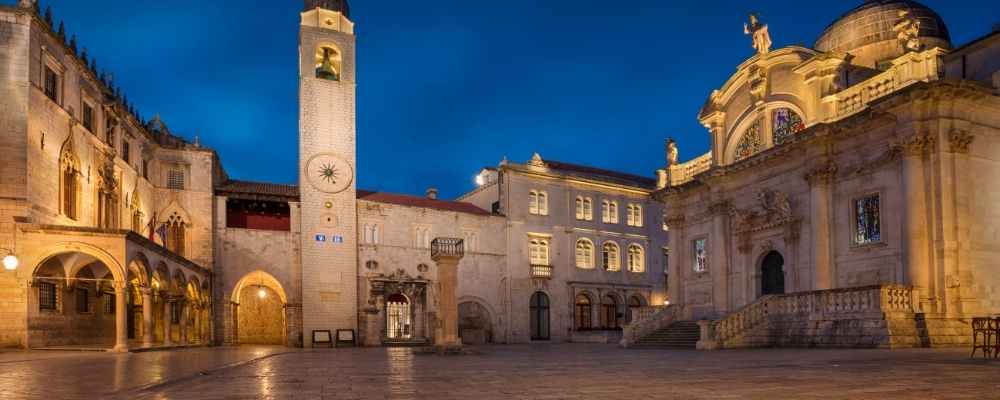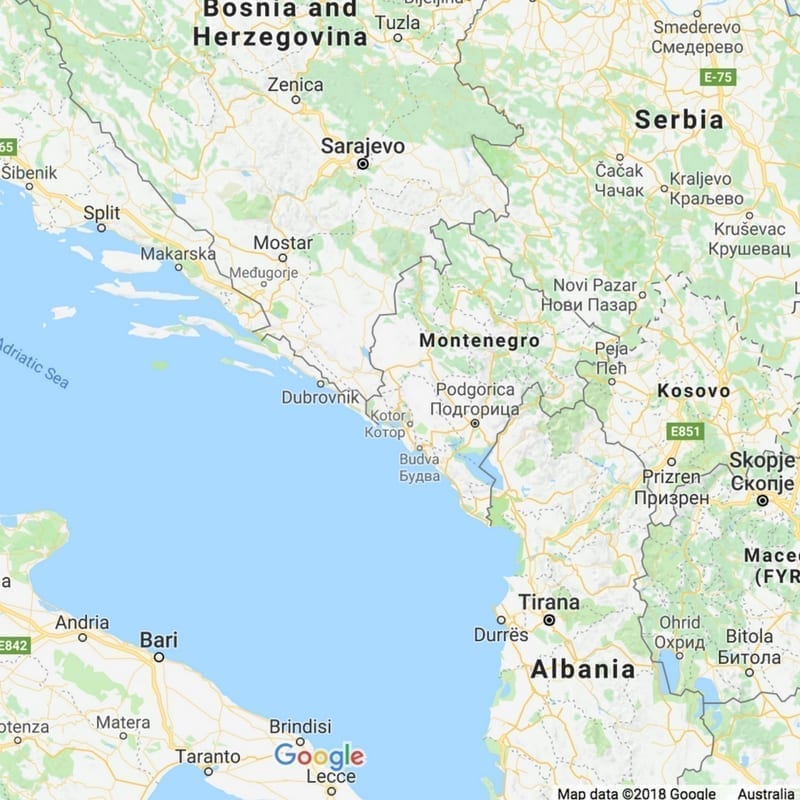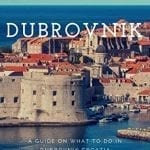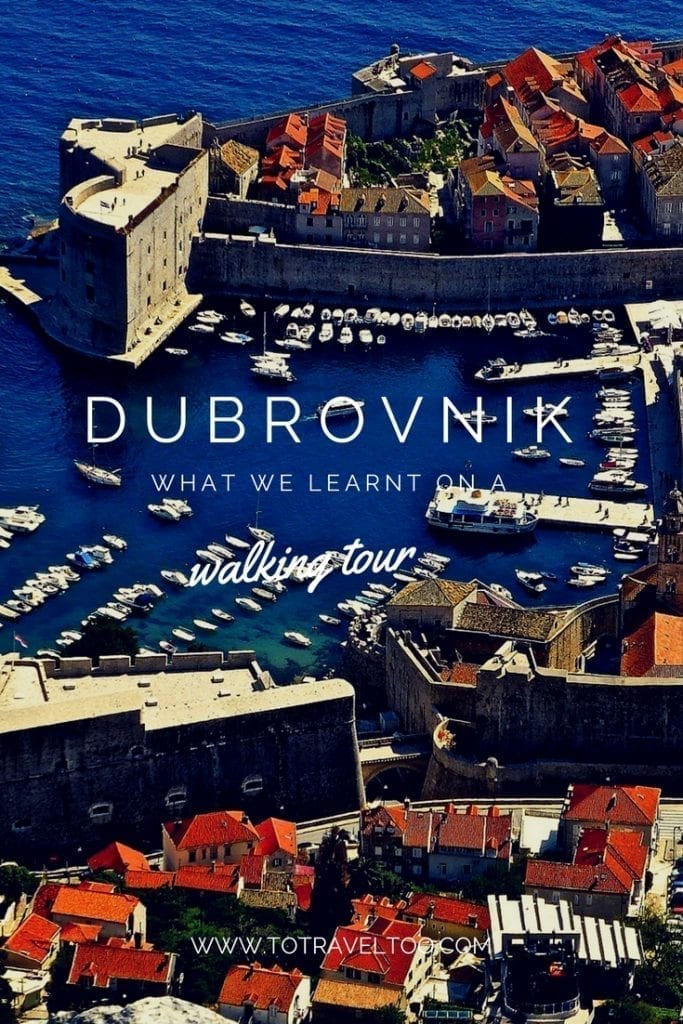Dubrovnik, the picturesque coastal city known as the “Pearl of the Adriatic,” is steeped in history and charm. As we embarked on a walking tour of this enchanting destination, we were captivated by its ancient walls, cobblestone streets, and stunning architecture. But beyond the breathtaking beauty lies a wealth of knowledge waiting to be discovered.
Join us as we delve into what we learnt during our immersive adventure through Dubrovnik’s hidden treasures and unravel the secrets that make this UNESCO World Heritage site so fascinating.

Pile Gate is the hub of Dubrovnik, it is where the buses depart from and where tour groups meet.
Sandra, our tour guide from Dubrovnik Tourism, was very passionate about her hometown of Dubrovnik and we spent the next hour enjoying her company and her sense of humour whilst learning about “The Pearl of the Adriatic” – Dubrovnik.
Dubrovnik has some of the best beaches in Croatia and Sandra urged us to take some time off and visit one of her favourites – Sunset Beach.
Sandra also explained to us about Croatian cuisine and urged us to try as many Croatian Traditional Dishes as we can during our time in Croatia. Croatia is well-known for its gastronomic delights with influences from Turkey, Austro-Hungarian, Illyrian and Mediterranean cuisines.
This post may contain affiliate links. Please see our disclosure for more information. As an Amazon Associate, we earn from qualifying purchases (if applicable).
We enjoyed our time so much in Dubrovnik we have written an e-book on What to Do in Dubrovnik.
Our guide covers what to do, where to go, where to stay and recommendations for restaurants as well as tips and tricks.
Would you like to take a tour of the Old City Walls? Learn how the fortifications protected the prosperous city of Dubrovnik from its powerful enemies for centuries on this walking tour of its city walls and historic heart. Take in breathtaking views of the Adriatic Sea and Dubrovnik’s Old Town. This is a similar tour to the one we did.
Old Town Walking Tour (over 1700 reviews)
Tour highlights:
- Explore the heart of Dubrovnik’s Old Town with a local licensed guide
- Learn how the city became one of the most prosperous republics
- Visit and learn about Dubrovnik’s most significant historical landmarks
- Hear mesmerizing stories that makeup over 1,400 years of Dubrovnik’s history
Where is Dubrovnik
Dubrovnik Croatia is located on the beautiful Adriatic Sea. Croatia borders the countries of Bosnia and Herzegovina, Serbia, Montenegro, Hungary, Serbia and Slovenia.
Dubrovnik Map

The Walls of Dubrovnik
The Dubrovnik City Walls are 1,940m in length. They are the biggest and the best preserved in the whole of Europe.

Can you believe this? The City Walls were built between the 11th and 15th centuries to defend the city, but they never saw a war or an evasion until 1991 when Dubrovnik came under attack from Serbia. If you were a visitor to the city during its construction you were required to bring a stone with you from the outlying areas of Dubrovnik as your entrance fee to the city.
The walls are made up of 3 round, 12 rectangular, 15 bastions and 2 corner fortresses and at some parts, the walls are 25m high. When walking the Dubrovnik walls, morning is best it is cooler and less crowded, and check on opening times as they differ throughout the year. It took us nearly 2 hours to walk the walls as there were so many photographic opportunities. There are also cafes along the walk to enjoy a coffee, cold drink or just to have a rest and enjoy the views. When you walk the walls you must walk in a counter-clockwise direction due to its narrow pathways.
Fort Lovrijenac – or Kings Landing Croatia if you are a Game of Thrones Croatia Fan
The Fort is also known as the ‘Dubrovnik Gibraltar” and is located on a sea cliff 37 meters high outside the main walls of the Old City. On the Northside, the walls are between 4-6m thick and on the Southside only 1.3 – 3m thick whilst the walls on the Westside are the thickest coming in at 12m thick and on the city side only 60cm. If the enemy attacked the city side the thinness of the walls made it easy for those in the city to push back the attackers. At the entrance to the Fortress above the door. you will see a Latin inscription it means “You can’t sell freedom for any gold in the world” – this has been the Republic of Dubrovnik’s motto for centuries.
The Games of Thrones TV series is filmed in many locations around the world. Kings Landing Dubrovnik stands out as one of the most impressive sites used in the series. The TV series has put Dubrovnik on the tourist track with many Games of Thrones Tours available. Some of the best Dubrovnik Games of Thrones tours are:
2 hour Dubrovnik Games of Throne Tour – prebook your tour before you travel included is a Throne Photo.
Tour highlights:
- Discover the real King’s Landing in Dubrovnik
- Visit location sites with a licensed Game of Thrones guide
- Admire the views of the Fort of St. Lawrence
- Take a photo on the 3D printed replica of the Iron Throne for free
A private Dubrovnik Games of Throne Tour
Tour highlights:
- Discover the Dubrovnik setting for “Kings Landing” from Game of Thrones
- Follow in the footsteps of King Joffrey, Tyrion and others
- Walk the city walls and cobblestone streets of Dubrovnik
A full-day Dubrovnik Games of Throne Tour
Tour highlights:
- See the Walk of Shame, King’s Landing, Red Keep, Iron Throne and the gardens of King’s Landing
- Visit one of the oldest arboretums in this part of Europe
- Have the best view of King’s Landing at Mount Srdj
The Early Days of Dubrovnik
Dubrovnik was founded by the Slavs during the 7th Century. 20km outside Dubrovnik lies the town of Cavtat which was settled by the Romans and was originally named Epidarum. Refugees from here built a new settlement on the island of Lausa and other occupants in the area settled along the coastline across the narrow channel which was known as Dubrovnik. During the 9th century this channel was filled with earth, which connected the two settlements, and today it is known as the main street of the Old City – Stradun.
Some important dates:
- From the 9th century to 1205 Dubrovnik was under the rule of the Byzantine Empire.
- 1205 – 1358 Venetians ruled the city
- August 16, 1296, saw a fire that nearly destroyed the whole city
- 1358-1806 – the Republic of Dubrovnik was a free state, it had its own currency, own laws and was ruled by the Senate which contained 50 members, an executive body, that made all the decisions
- During the 15th century – Dubrovnik was a Maritime State with 500 sailing vessels and 5000 sailors. Their shipbuilding industry was well-developed. Trade by sea and land was very important to the State.
- For 500 years Dubrovnik was a free zone, they negotiated with the Turks to keep their freedom and in doing so paid 12,000 golden ducats for the privilege
- April 6, 1667, an earthquake destroyed much of the city and killed 5,000 people
- In 1806 Napolean tricked the Government, he asked for permission to pass through the State and stayed.
- 1808 the Republic was dissolved
- 1815 it became under the Austrian-Hungarian Monarchy
- After World War I Dubrovnik became part of the Kingdom of Yugoslavia
- During World War II Dubrovnik became under the rule of the Communists – the Socialist Republic of Croatia and the Social Federal Republic of Yugoslavia.
1991 – 1995
On October 1, 1991, Dubrovnik was attacked by Serbia, the attack lasted for several months. The worst casualties, 19 killed and 60 wounded, occurred on December 6. For 3 months the city was without power and water, even Onofrio’s Fountain water supply was cut. The last bombing occurred during 1995.
80% of roofs were completely destroyed in the Old City. The 18 Churchs within the Walls all suffered some form of damage. The people of the City managed to save some of their important monuments by protecting them with wood.
When you enter the city from Pile Gate, head towards the Old Map on the Wall which shows the damage during this time. Red spots denote completed destroyed, circles show roof damage and other circles show pavement damage. You will also note as you walk down the Stradun that the tiles are new, they were replaced after the war.
Drawbridge at Pile Gate Entrance Dubrovnik

For 500 years from the 14th century to the 19th century, the drawbridge was lifted up first thing in the morning and let back down in the evening. Only the residents of the city were allowed to stay in the city overnight, in this way it kept the city safe. Guards were placed on the city walls and the Rector held the keys to the two gates.
St Blaise Patron Saint of Dubrovnik

St Blaise is the Patron Saint of Dubrovnik. He originally came from Romania and was a Bishop as well as a Doctor. Legend states that during a dream he had a vision of Dubrovnik under attack from the Venetians, and he was able to warn the residents of the forthcoming surprise attack from the Venetian ships who were supposedly in the harbour to take on fresh water supplies.
St Blaise is also known as the Protector of the Throat. A young boy was brought to him choking on a fishbone, St Blaise positioned his hands on the young boy’s throat, prayed to God and healed him.

Today the Festival of St Blaise starts on February 2 and runs for several days. Locals attend St Blaise’s Church in Luza Square inside the city walls.
There are statues of St Blaise within the city walls and each one shows him holding the city in the palm of his hands.
Other Buildings To Visit Within The Walls of Dubrovnik Old Town

The first church on the left as you enter the City from Pile Gate. The Senate commissioned the construction of the Church in 1520 after an earthquake in the city killed 20 people. It was built in the Renaissance style. It withstood an earthquake during 1667 which killed 5000 residents.
St Franciscan Monastery Dubrovnik
Established in 1317 it contains the 3rd oldest Pharmacy in Europe. The herbs used for medicinal purposes were originally planted by the Monks.
Small Canals inside the City Walls of Dubrovnik
Look down as you walk around the Old City and you will find small canals in the streets, actually, you may smell it before you see it. This is the oldest sewerage system in the world which dates back to 1317.
Lazareti (Quarantine Hospital) Dubrovnik
The Hospital was built during the 14th century and was a home for the elderly people of the Old City.
The Hospital was also used as a Quarantine Hospital for sailors where they needed to stay for 40 days after returning from their voyages.
The Orphanage Dubrovnik
The oldest Orphanage lies within the City Walls and it is still operating today as a home for orphans. It was forbidden for Noblemen to marry commoners and as a result, many mothers were forced to give up their babies. They would travel to outlying villages to give birth. At night they would come to the Orphanage, ring the bell, the Nuns would open the secret door where there was a wooden turntable. The mother would place her baby onto the turntable with a piece of cloth so that if her circumstances changed, she would be able to return and identify her child, she then would turn the board back around towards the Nuns. When the child turned 6 years of age he or she would then be adopted out if the Mother had not returned.

The first thing you see as you enter the entrance to the Old City is a huge central dome that is Onofrio’s Fountain. 16 water taps have been supplying water to the city from the mountains since the 15th Century, it is cool, fresh and potable, you will see locals filling up their water bottles daily. We filled our bottles up on numerous occasions and had clear fresh cool tasty water!
Houses along the Stradun Dubrovnik

The Stradun, the main street of the Old City, houses the Baroque buildings along its length of 292 meters from the main city square. The houses were built with the ground floor containing their shops, the first floor was used for their living areas and bedrooms and the top floor was their kitchens. Kitchens were built on the top floor in case of fire, fire travels upwards and it was more cost effective to replace a kitchen and a roof instead of the whole building.
Dubrovnik houses the 2nd oldest Jewish Synagogue in the world, the oldest is in Prague. The Jews came from Spain as refugees in 1492, they felt privileged to be able to reside there. Many became traders and craftsmen. During World War 2, 250 were taken to the Island of Lopud and then to a Concentration camp. Today there are only 40 left living in the street. Three times a year a Rabbi from Zagreb comes to the City to celebrate their Holy Days.
At the end of the Stradun is the meeting point for tourists and locals alike at Luza Square. Surrounding the Square are Dubrovnik’s most important buildings – St Blaise Church, The Treasury, Palace of the Rector, the Customs House and sitting proudly in front of St Blaise Church is Orlando’s Column a statue dedicated to the Knight Roland.

The statue is a symbol of freedom for the city, his elbow has been used as the official measurement of length 5.15cm (originally the Ragusan cubit).
Luza Square is the centre for Christmas and New Years Eve Celebrations.

Located at the end of the Stradun in Luza Square lies the Bell Tower which dates back to the 15th Century. On top of the 31 meter high, Bell Tower are two soldiers made from bronze called Maro and Baro who strike the 2-tonne iron bell. At midday, the bells strike 12 times and then repeating the strike again after 3 minutes – just in case you missed the first! On the half-hour the bells strike once.
In Luza Square is the 16th-century Sponza Palace built in the Gothic and Renaissance style. It was originally used as the Customs Office and the Mint, today, it houses the States Archives.
The Rector’s Palace was the centre of political power in the city. The Rector was elected from the Noble Families and ruled for only one month, he could be re-elected only after 2 years had passed. During his rule for that one month, he was not allowed to leave the Palace, only for official engagements of religious holidays.
There were 3 classes within the city:
- Nobles who had the money and the power
- Citizens who had the money and no power
- Commoners who had no money and no power

Gundulic’s Square is the only open-air market within the walls of the Old City, there is another open market located at Gruz Port where the large ocean liners come into. During the hours of 7 am to 12 pm, it is a small market selling fruit and vegetables, honey, lavender, and local sweets made from almonds and oranges. After 12 pm the Square becomes a busy restaurant and cafe area.

88% of Dubrovnik’s citizens are Catholic. There are 18 Churches, 1 Orthodox Church, 1 Synagogue and 1 Mosque in the city.
The Cathedral was built in 1715 on a site that originally housed a 12th-century Romanesque church which was destroyed during the earthquake of 1667.
Within the Cathedral the Treasury contains many rare relics and paintings and near the main altar is a painting by Titian – Ressurection of Maria.
Legend states that Richard the Lionheart returning from the Crusades was shipwrecked on the island of Lokrum. He vowed to give his thanks by building a church on the island but instead he was coerced to build it in Dubrovnik by the City’s leaders. Crafty leaders!
The Old Port still looks the same as it did during the 15th century. It houses the Maritime Museum, many restaurants and is the port for the ferry to Lokrum Island. Today the restaurants’ Arsenal and Poklisar are located where the Large and Small Arsenals were based for the building and repairing of the ships, it was the hub of the trading fleets.
Cruises from the Old Port of Dubrovnik
There are some cruise options available with departures from the Old Port:
2 Hour Game of Thrones Tour and Cruise
Tour Highlights:
Lunch Cruise to Elaphiti Island
Tour highlights:
- Feel the wind in your hair as you enjoy a drink from the onboard open bar
- Gaze out over the Adriatic sea as you savor a mouth-watering lunch
- Be picked up and dropped off directly at your accommodation in Dubrovnik
- Visit the popular islands of Koločep, Lopud, and Šipan in just one day
- Take free time to explore and experience the islands on your own terms
Life Within The City Walls of Dubrovnik Today
Dubrovnik Croatia receives 2 million visitors a year, 1 million who stay in Dubrovnik and 1 million who arrive daily via cruise ships. Dubrovnik has 50,000 residents with 800 of those living in the Old City.
It is expensive to live in the Old City. Deliveries must be by hand which increases the costs of all products. Residents are moving out, their properties are being converted into accommodation rentals. There is one primary school but numbers are dwindling as residents leave. Residents are finding it difficult to live with so many tourists visiting. You don’t need a gym if you live in the Old City, some streets have only 200 steps!!!
Dubrovnik has become a UNESCO World Heritage site since 1979.
Where to stay in Dubrovnik
We stayed 20 minutes outside Dubrovnik at the Sun Gardens Dubrovnik located at Na Moru 1, Orasac.
The Sun Gardens has all that you want in a resort, great restaurants, a stunning location and activities for couples and families. You must try their Spa and Wellness Centre.
If you are after self-catering accommodation we can recommend Apartment Nikol.
The apartment is located at Lopudska 5 and offers comfortable 3-star accommodation with great views and good wifi. There is a bus service that will take you to the Old Town or it is a pleasant 25-minute walk away.
There are 2 hotels within the City walls and 44 hotels outside.
Scalini Palace: Boskoviceva Ulica 3 Dubrovnik City Centre
Housed in a fully renovated 16-century manor, Scalini Palace is set just a few steps from the Stradun Promenade in the UNESCO-protected Old Town of Dubrovnik. Complimentary WiFi is provided throughout the property.
Guest review: Lovely location in the heart of the old city
Boutique Hotel Stari Grad: Od Sigurate 4, Dubrovnik City Centre, Dubrovnik,
Fully renovated in the summer of 2013, Stari Grad is one of only 2 hotels within the Old Town walls of Dubrovnik. This historic residence offers 8 spacious guest bedrooms and free Wi-Fi in all areas.
Guest review: Beautiful, charming hotel in the heart of Dubrovnik. Fantastic room. Helpful, friendly staff. Breakfast on the rooftop was beyond! Not only was the food exceptional, the views took our breath away.
More Hotels in Dubrovnik

Cheap Flight Deals to Dubrovnik
Find the cheapest flights with Skyscanner our ‘go-to’ when researching and booking flights throughout the world. You can sign up for their fare alerts when the fares that you are looking forward go up or down before booking.
Book your private transfer from Dubrovnik Airport to Dubrovnik Town here.
Bus Travel Around Croatia
We travelled around Croatia and Montenegro by bus.
For the latest bus schedules and ticket prices click here.
Car Rental in Croatia
We use AutoEurope for car rental around Europe. Click here for their latest deals.
Travel Insurance
We recommend taking out travel insurance as soon as you book your flights and pay deposits on any cruises, tours or hotels.
In conjunction with Amazon, we have created a To Travel Too Travel Shop with over 800 travel-related products from books, walking shoes to jackets and luggage.
Are you on Pinterest? We are at To Travel Too and we have many travel-related boards check us out at Pinterest. If you enjoyed our article why not pin it to your board.
You may enjoy reading our articles on Dubrovnik:
Panorama Restaurant – Reservations Required View Complimentary
Dubrovnik Tips from an Insider
3 Good Reasons to Visit Ston in Croatia
You can now download our article to your Phone to enable you to walk Dubrovnik with GPS locations.
To Travel Too Travel Shop
Travel smarter and safer with products from our To Travel Too Travel Shop. If you are looking for the latest luggage, guidebooks or travel accessories we have you covered with over 800 travel products to choose from.









I completely love walking tours. The first thing I look for in an European city is to find a walking tour whether it’s with Sandeman’s or other walking tour companies. You had a great time while having the walking tour organized by Dubrovnik Tourism. So much of history to know about a city – loved how you were taken to all the important sites of the city and were informed about the history of the place.
Hi Shreya
Thanks for your comments. Walking tours are a great way to see a city.
Cheers Jane and DUncan
Dubrovnik seems like such a beautiful place. It’s full of historical monuments I see. We are planning to visit to Croatia in the month of September and thanks to this post I have all the info about Dubrovnik. Will definitely keep it in the itinerary.
My friend is a Games of Thrones super fan. He has mentioned that he wants to visit Dubrovnik simply for the GOT tours. The orphanage and Luza Square are what I most want to see in person.
Hi Cat
Thanks for your comments. I hope you and your friend get to visit Dubrovnik.
Cheers Jane and Duncan
You had a great walking tour in Dubrovnik and too guided by Sandra from their official tourism board. I was not knowing that this city has biggest wall in Europe. Also it would great to see locations of Games of Thrones.
Dubrovnik is such a picturesque town with an old world charm. A walking tour looks like a walk back in time. The place seems simply oozing with culture and heritage. Have fallen in love with this beautiful place ever since it featured in a famous Bollywood movie, Hope to get there one day.
Oh wow…how cool is getting a guided tour from someone who is as passionate as a traveller to a city. Lucky you! I’ve never heard about this city and this post is definitely informative and interesting. Looks like the fountain has a hidden freshwater spring 🙂 I wonder what would be the story behind brick(stone) as an entry fee during those days. maybe a barter deal ! Lovely post.
Hi
Thanks for your comments. Dubrovnik is such an amazing city and a walking tour is a must.
Cheers Jane and Duncan
We had a fantastic week in Dubrovnik in 2017 with our teenage son. One thing I would absolutely recommend is a day on Lokrum Island to swim, relax and explore the history of the island. There are two islands one can visit from Dubrovnik, one with a beach and Lokrum. Lokrum is more rocky but there are metal steps down into the water in a variety of places. There are restaurants, cafes, picnic areas, a safe swimming hole for littlies and tiny rabbits and peacocks. The animals are well used to humans and will happily feed from your hand. It was a wonderful respite from the heat, the water is clear and cool and it is a fabulous day out.
As a baby boomer, albeit at the tail end, and as a travel freak I enjoy your blog very much.
Hi Peggy
Thank you so much for your comments. Dubrovnik is such a beautiful place to visit. Lokrum Island is a very special place to visit as well. It is good to know that it is safe for swimming. Enjoy your travels.
Cheers Jane and Duncan
I didn’t know Dubrovnik had the second oldest synagogue, that’s really interesting! What a cool walking tour. I’ve been to a bunch of European cities, but sadly not here yet. Bookmarking for when I do!
Hi Eileen
Thanks for your comments. It is amazing what you learn on walking tours. We love them.
Cheers Jane and Duncan
I think that Croatia is one those place where exploring places via walk is much enjoying and amazing. The you may explore old wall, green mountains and beautiful seashore as well. It is also worth it.
Hi
Thanks for your comments. We have fallen in love with Croatia and Dubrovnik.
Cheers Jane and Duncan